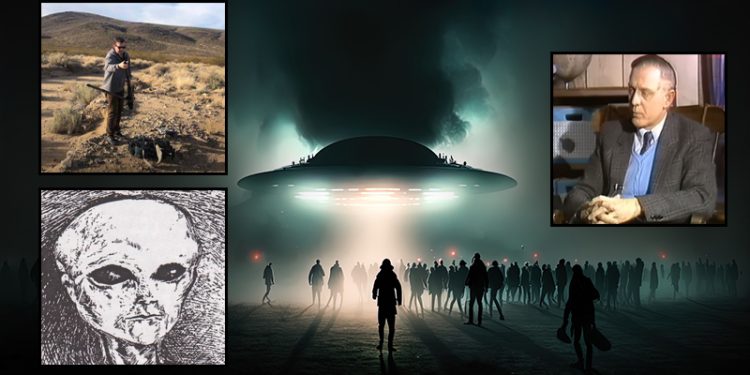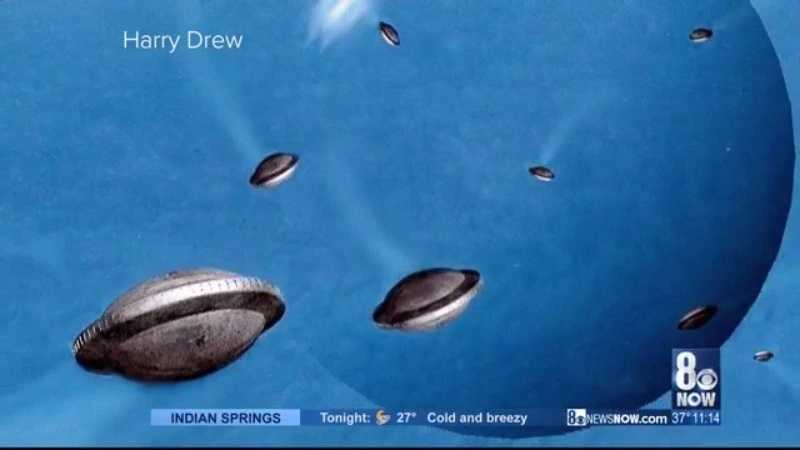In 1953, the Atomic Energy Commission conducted a series of powerful explosions at the Nevada Test Site, known as “Upshot Knothole.” During the same period, witnesses reported seeing eight unidentified flying objects engaged in a dogfight near Arizona.

Historian and former museum curator Harry Drew spent ten years investigating the incident and discovered that three of the craft had crashed on the outskirts of Kingman, Arizona in May 1953.
Drew did not expect to find evidence of the Kingman UFO and was surprised to learn about the third crashed craft. Mystery Wire reports he researched old records and interviewed original witnesses to uncover a complicated story that was more intricate than the Roswell UFO crash story.
In 1973, a retired Nevada Test Site technician named Arthur Stansel revealed that he and his team were taken to a remote desert location in Arizona to recover a secret experimental craft that had crashed. The team found a perfectly intact 40-foot diameter disc-shaped craft with four alien beings associated with it, and it was shipped to Groom Lake, Nevada, where Area 51 was later built around it.

In his book, “7 Days in May: The Kingman UFO Story,” Drew describes what happened to the three crashed crafts. One was destroyed when it crashed into a mountain near Kingman, another was found intact miles away from the crash site, and the third one crashed next to a small reservoir after clipping a rocky butte. The military took the last unknown craft back to a Nevada base. He found military-issued food containers dating back to 1953 around the exact crash site, proving that military teams camped there.
UFO enthusiasts have speculated that the Kingman UFO incident might be linked to the nuclear tests conducted in Nevada. However, Drew’s research suggests that the cause was a trio of powerful experimental radar sites set up around Kingman.
Drew claimed that he was able to document the crashes and the secret transport of the crafts to Nevada. He also asserted that one of the crafts was entirely intact when discovered. Despite the hotly contested nature of the story, Drew has evidence to support his findings.
According to MUFON researcher Richard Hall, in April 1964, the first report of a crash near Kingman was relayed to him by a future Vietnam commander. However, it was not until June 1973 that the case of the Kingman UFO retrieval was brought to the public’s attention by renowned UFO researcher Raymond Fowler.
The incident involved an engineer, Arthur G. Stancil (also known as “Fritz Werner”), who took preliminary measurements to assess the momentum of the crashed craft, which could prove useful in any reverse engineering attempts. Stancil, an Ohio University mechanical engineering graduate, who worked at Wright-Patterson Air Force Base in Dayton, Ohio, first made the story public.
Dr. Eric Wang, who was suspected of leading a reverse engineering team on alien craft, headed the Installations Division within the Office of Special Studies where Stancil worked. Stancil provided an affidavit in April 1976 vouching for the honesty of his testimony, which was released by Ray Fowler in the UFO Magazine. In his statement, Stancil revealed that he was loaned out to the Atomic Energy Commission and designated as a project engineer on some atomic bomb tests referred to as “Operation Upshot Knothole.”
The craft was reported to have a brushed aluminum exterior finish, measuring approximately 30 feet in diameter, and contained two swivel seats, instruments, and display panels. The hatch was five feet high and three feet wide. Additional reports from the book “Majic Eyes Only,” written by Ryan S. Wood, indicate that the craft was embedded 20” into the desert sand on impact.
Re-Engineered UFO And Four Aliens
There are varying reports about the number of extraterrestrial biological entities (EBEs) recovered at the crash site. Some sources claim that four small EBEs were recovered, while others state that only one was found. Despite these discrepancies, there is evidence to suggest that a military blockade was set up along Highway 40, possibly in 1953, to secure the area leading to and from the potential crash site.
It is unclear whether the military recovered objects of extraterrestrial origin and transported them to a clandestine hangar, but there are reports of crashed discs being housed at a top-secret facility known as Area S-4, located 12 miles south of Area 51.
According to Wendelle Stevens, a retired US Air Force pilot-turned-UFO researcher, the disc that crashed near Kingman was transported to Area 51 via a U.S. Army tank transporter. The recovery crew attempted to tilt the craft on end to facilitate transportation across the country but abandoned this procedure when it became clear that it was impossible. Telephone poles had to be removed when the main road intersected with unimproved surfaces or dirt roads due to the oversized load of the disc on the trailer.





